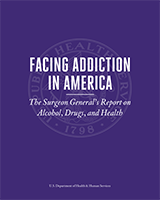NCBI Bookshelf. A service of the National Library of Medicine, National Institutes of Health.
Substance Abuse and Mental Health Services Administration (US); Office of the Surgeon General (US). Facing Addiction in America: The Surgeon General's Report on Alcohol, Drugs, and Health [Internet]. Washington (DC): US Department of Health and Human Services; 2016 Nov.

Facing Addiction in America: The Surgeon General's Report on Alcohol, Drugs, and Health [Internet].
Show detailsTable 3.1Risk Factors for Adolescent and Young Adult Substance Use
| Risk Factors | Definition | Adolescent Substance Use | Young Adult Substance Use |
|---|---|---|---|
| Individual/Peer | |||
| Early initiation of substance use46,47 | Engaging in alcohol or drug use at a young age. | ✓ | ✓ |
| Early and persistent problem behavior48,49 | Emotional distress, aggressiveness, and “difficult” temperaments in adolescents. | ✓ | |
| Rebelliousness48,50 | High tolerance for deviance and rebellious activities. | ✓ | ✓ |
| Favorable attitudes toward substance use51,52 | Positive feelings towards alcohol or drug use, low perception of risk. | ✓ | ✓ |
| Peer substance use53-55 | Friends and peers who engage in alcohol or drug use. | ✓ | ✓ |
| Genetic predictors56 | Genetic susceptibility to alcohol or drug use. | ✓ | ✓ |
| Family | |||
| Family management problems (monitoring, rewards, etc.)57-60 | Poor management practices, including parents' failure to set clear expectations for children's behavior, failure to supervise and monitor children, and excessively severe, harsh, or inconsistent punishment. | ✓ | ✓ |
| Family conflict61-63 | Conflict between parents or between parents and children, including abuse or neglect. | ✓ | ✓ |
| Favorable parental attitudes64,65 | Parental attitudes that are favorable to drug use and parental approval of drinking and drug use. | ✓ | ✓ |
| Family history of substance misuse66,67 | Persistent, progressive, and generalized substance use, misuse, and use disorders by family members. | ✓ | ✓ |
| School | |||
| Academic failure beginning in late elementary school68,69 | Poor grades in school. | ✓ | ✓ |
| Lack of commitment to school70,71 | When a young person no longer considers the role of the student as meaningful and rewarding, or lacks investment or commitment to school. | ✓ | ✓ |
| Community | |||
| Low cost of alcohol30,72 | Low alcohol sales tax, happy hour specials, and other price discounting. | ✓ | ✓ |
| High availability of substances73,74 | High number of alcohol outlets in a defined geographical area or per a sector of the population. | ✓ | ✓ |
| Community laws and norms favorable to substance use75,76 | Community reinforcement of norms suggesting alcohol and drug use is acceptable for youth, including low tax rates on alcohol or tobacco or community beer tasting events. | ✓ | ✓ |
| Media portrayal of alcohol use77-79 | Exposure to actors using alcohol in movies or television. | ✓ | |
| Low neighborhood attachment80,81 | Low level of bonding to the neighborhood. | ✓ | |
| Community disorganization82,83 | Living in neighborhoods with high population density, lack of natural surveillance of public places, physical deterioration, and high rates of adult crime. | ✓ | |
| Low socioeconomic status84,85 | A parent's low socioeconomic status, as measured through a combination of education, income, and occupation. | ✓ | |
| Transitions and mobility80,86 | Communities with high rates of mobility within or between communities. | ✓ | |
- Table 3.1, Risk Factors for Adolescent and Young Adult Substance Use - Facing Ad...Table 3.1, Risk Factors for Adolescent and Young Adult Substance Use - Facing Addiction in America
Your browsing activity is empty.
Activity recording is turned off.
See more...